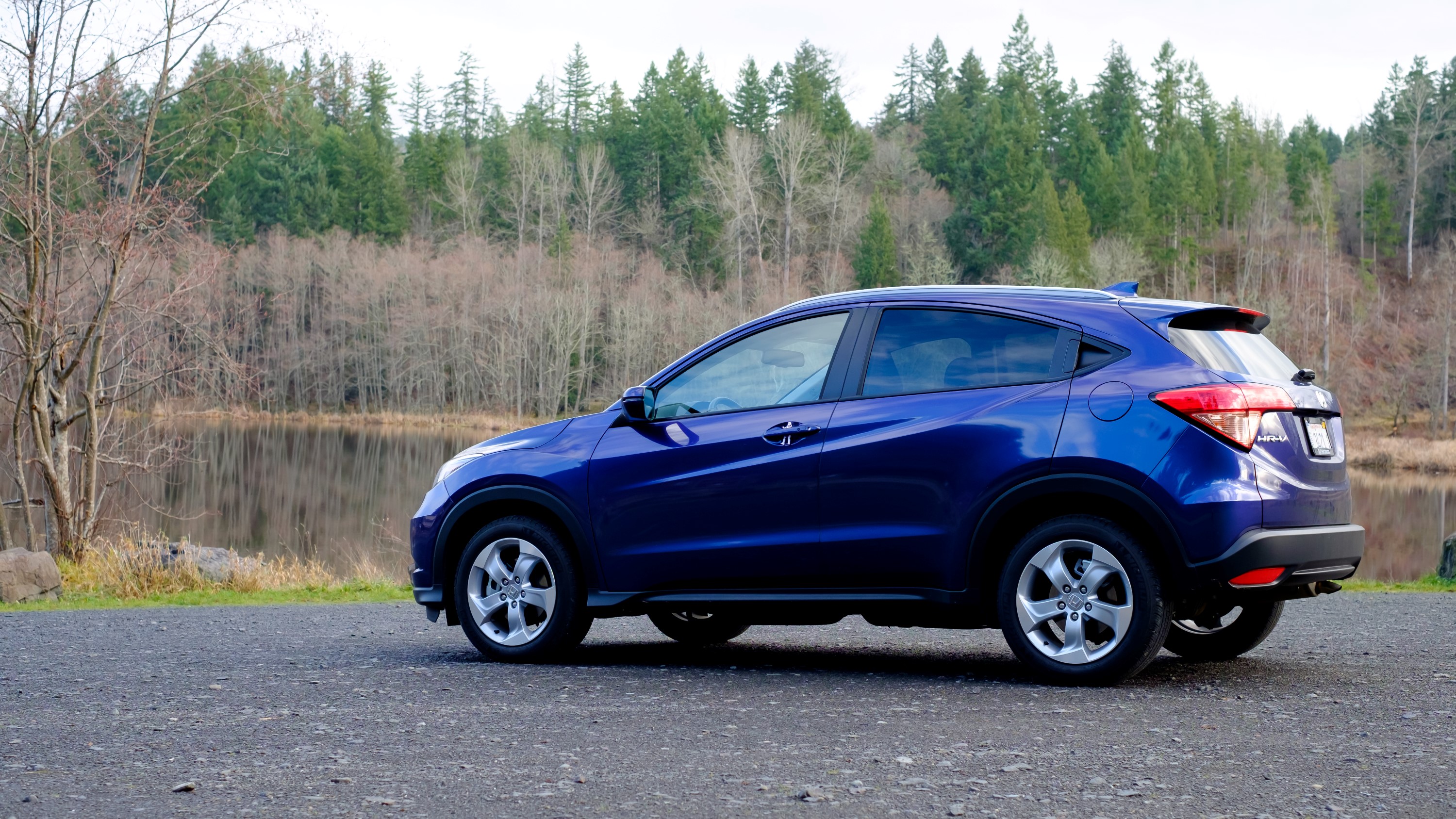Why you can trust TechRadar
Motivating the Honda HR-V is a 1.8-liter, four-cylinder engine mated to a continuously variable transmission (CVT), a rather unexciting powertrain combination. Power from the 1.8-liter motor is a lowly 141 horsepower (hp) and 127 pound-feet (lb-ft) of torque.
The motor has plenty of power to get around town and merge at a safe speed, but the HR-V is no speed demon. While I usually toss the car on my friend's vehicle dynamometer at Drift-Office to verify hp ratings, there wasn't an available appointment when I had the HR-V for review.
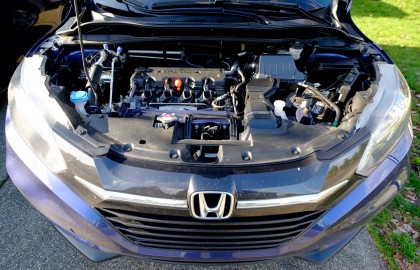
Power is sent to all four wheels via Honda's Real Time AWD with Intelligent Control system. The part-time all-wheel drive (AWD) system only moves the front wheels unless it detects a loss of traction. If the system detects a loss of traction, it automatically engages the rear wheels to help. My experience with the HR-V's AWD system is it lets the system understeer (the car doesn't turn enough) before engaging the rear wheels to help.
Other available systems can provide the feeling of oversteer (turning too much) before kicking in the other wheels or provide seamless grip and steering so you don't notice the AWD working at all. I've driven all types of AWD systems, and the HR-V's understeer-biased system isn't as ideal as the seamless systems used in higher-end Acura's such as the MDX, but better than the oversteer-biased systems typically installed with rear-wheel-drive (RWD) based cars from BMW, for inexperienced drivers.
The CVT differs from traditional automatic transmission by providing greater efficiency due to the lack of standard gears. Automatic transmissions have a set number of gears with different ratios to propel the car forward. CVTs have an infinite number of gear ratios that adjusts to always have the engine running at peak efficiency. The trade-off is better fuel economy with CVTs, but it numbs the driving experience.
Regardless, the beauty of the CVT is greater efficiency for good fuel economy, which the US Environmental Protection Agency rates the HR-V at 27 miles per gallon (mpg) in the city, 32 on the highway and 29 combined. My driving yielded 26 mpg average, which is impressive to me since I have a lead foot.
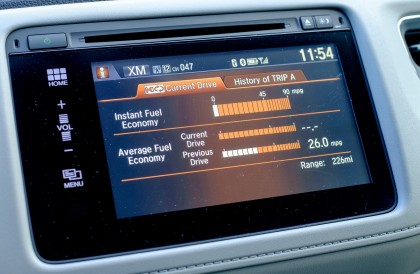
The downside is driving the HR-V is a thoroughly boring experience. The CVT is extremely smooth when accelerating at full throttle, but as soon as you let go of the gas pedal, there's a slight elastic sensation in which the car feels like a stretched out rubber band. This is typical of all CVTs and more noticeable on lower hp applications, like the HR-V.
It's a shame the CVT sucks the life out of the car, as the chassis and suspension tuning is excellent. The car handles windy roads with confidence and minimal body roll. The suspension isn't too stiff, while the dampers mitigate bumps in the road without sacrificing road feel.
Steering response is excellent and has the right amount of weight and precision without the need of selectable drive modes. The HR-V would be an enjoyable car to drive if it weren't for the CVT. However, Honda does offer a six-speed manual transmission on LX and EX trim levels, but it's only available on front wheel drive (FWD) models.
Living with the car
Despite being a sub-compact CUV, the Honda HR-V is deceptively spacious. It's small on the outside but a smart back seat and cargo area makes it perfect for pet owners and families. Take the Honda Magic Seat system for the back seat, for instance: it's a genius idea. The seat backs not only fold down to maximize cargo space, but the seat bottoms fold up to provide an open space for pets while keeping the cargo area closed off.
In terms of family friendliness, we partnered up with Diono, a car seat manufacturer, to test-fit three car seats in the back of the HR-V. Diono's USA headquarters is in Puyallup, Wash., where I conduct vehicle testing and a convenient place to stop by and test-fit car seats. With the help of Diono, I attempted to install three Radian RXT convertible car seats in the back of the HR-V.
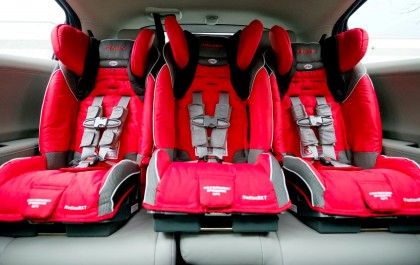
Honda provides two pairs of LATCH anchors for the outboard seats, which is typical of all new cars nowadays. The middle seat requires the use of the three-point seat belt for installation. Top LATCH anchors are available for all three seats. The car seat installations are completed using the three-point seat belt instead of LATCH, because LATCH has weight limitations that can vary by car.
The Honda HR-V narrowly passed the car seat test. I tried installing a rear-facing seat in the center, and front-facing seats in the outboard seats, without any luck. The rear-facing seat wouldn't secure properly due to the mechanism for the Magic Seats.
However, I was able to install three front-facing car seats safely in the HR-V. I found it very impressive considering how small of a car the HR-V is.
Junk in the trunk
Honda doesn't employ any fancy smart trunk features in the HR-V. There's a trunk release button and an old-fashioned, open-it-yourself rear hatch. Since the car has passive keyless entry, you can unlock and open the trunk without taking the keys out of your pocket.
HR-V models with AWD have 23.2 cubic feet (cu-ft) of rear cargo space with the rear seats up. FWD models have an extra 1.1 cu-ft of space since it doesn't have to accommodate the rear drive line. I keep a Sumo Gigantor and Omni from Sumo Lounge around for trunk space testing. The Gigantor is a little too big to carry in and out of my house, so I stick to using the Omni for most cars. It's a fun way I devised to show how big a trunk is.
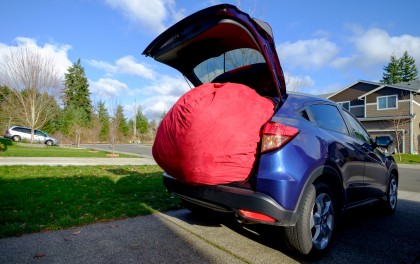
I dragged the Sumo Omni outside on one of the few sunny days we've had in Washington State recently to shove the bean bag into the back of the HR-V. I got the Sumo Omni a third of the way in with the back seats up and it fit no problem with the back seats down. The beauty of a hatch is fitting tall objects, which the HR-V should have no problems with.
In terms of trunk space, the HR-V has plenty of space to fit luggage for a weekend get-away for a family, as long as you pack lightly.
